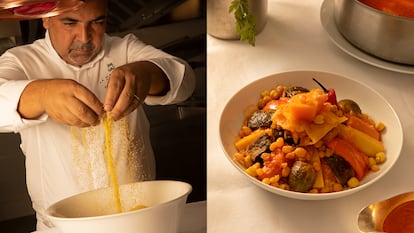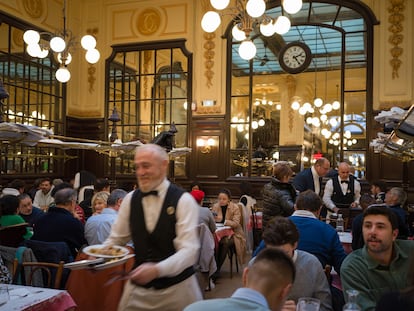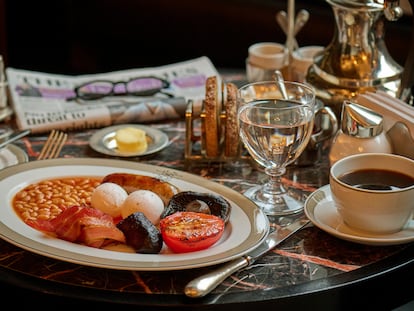Here’s the recipe (and history) of one of the best Moroccan couscous, La Mamounia’s version
Rachid Agouray, chef at Moroccan restaurant La Mamounia, in Marrakesh, looks for balance between tradition and contemporary cuisine that continues to recognize local flavors


“There are as many couscous recipes as people who eat couscous.” Faced with such a statement, Rachid Agouray (50 years old) smiles skeptically, hesitates, and offers a hearty denial: “There’s not so many, it’s one thing that everyone thinks they know how to make couscous… That, I’ll give you”.
Agouray is the executive chef of the Moroccan restaurant La Mamounia and the second head chef of the Marrakesh Palace, which just celebrated its 100-year anniversary and was sixth on this year’s list of the world’s 50 best hotels. King Mohamed VI often calls on Rachid to helm his official events, and Rachid represents Morocco in the elite Chefs des Chefs club, which brings together the chefs of heads of state.
It’s likely that this man makes Morocco’s best couscous. With a generous smile, he allows us to enter his kitchen, caress his pans and stick our noses in its spices. The refinement and smell of oranges and ripe dates so typical of La Mamounia remain upstairs. In the kitchen, ceilings are low, it’s hot, and they work hard and in a hurry. It smells of cumin, harissa, cinnamon, saffron and black pepper. Not necessarily in that order. When the job becomes particularly tense, Rachid applies anti-stress therapy: he escapes to the vegetable garden and walks to the end of its plots. There, he finds the peace he needs to return to the kitchen.
Rachid came to La Mamounia at the age of 16, and just turned 50. He trained with Boujemaa Mars, the hotel’s former chef, his father-in-law and a kind of spiritual parent. His team is comprised of 96% women who have learned the local recipes from mothers and grandmothers. The chef’s mission is delicate, to respect tradition and keep it alive, while creating a contemporary and sophisticated cuisine, in which the flavors of Morocco can still be recognized.
We’ve come down to the kitchens because Rachid is about to cook one of his star recipes for EL PAÍS, the couscous with seven vegetables. It is a Berber dish that is prepared in large quantities to feed the whole family, and which he has adapted to serve 10 customers. “The secret of Moroccan cooking lies in knowing how to use spices, and not letting them use you. Each recipe has its own mix, and they are not interchangeable. We use turmeric, saffron, cinnamon, but in order and proportion. Some dishes are sweet and salty at the same time”. To one side, a tray full of small jars of colored powders guards this mystery. His other commandment is to respect timing. “Many recipes are prepared the night before, they are marinated, they demand time and you have to give it to them. If you are in a hurry, don’t start making couscous,” he says.
As he mixes the semolina, aerating it, lifting pieces with his fingers, the chef insists that this is not a laissez faire process. There are rules, ratios, a specific blend of spices and technique for cooking the semolina. “If you add garlic and cumin, it doesn’t matter how well you do the rest of it, it’s going to be a disaster for sure”. According to the recipe that he later sends us in written form, the only acceptable spices for this version of couscous are powdered ginger, saffron, parsley, cilantro and cayenne.

Cayenne, cumin, cinnamon, turmeric and saffron are some of the spices endemic to Moroccan cuisine. When it comes to their blends, the most well-known in Morocco has been the ras el hanout, which can feature 18 or more spices. Rachid says that Berber women have been mixing the spices of the ras el hanout for 11 centuries, including his own grandmother and mother. He says that each family has its own version and that they don’t share recipes. No two mixes are the same. The Agouray family’s uses cardamom, cinnamon, black pepper, nutmeg, cumin, walnuts… And he won’t say what else. This isn’t the kind of information that leaves home. He’ll share the finished blend, but never the recipe.
His mission is to create a Mediterranean gastronomic concept that preserves Moroccan cooking and flavors. Many of these recipes can be sampled at the restaurant he runs at La Mamounia, where he has brought the international experience he gained working in luxury restaurants around the world, from Lucas Carton to Cipriani to the Hotel Du Palais in Biarritz. “I have managed to incorporate some ingredients from other cultures, but they are always cooked our way and with our spices to achieve the correct equilibrium of flavors,” he says.
During his years at La Mamounia, he has learned to be “patient” and “generous”. “That’s how they’ve treated me everywhere else, so I share what I know and what I have. It’s a way of life.”
Over more than three decades, he’s seen how the clientele has become evermore demanding and fickle. “Their tastes have not changed, but their habits have,” he sums up. “Before, it was enough that a dish was delicious, now its presentation is very important, the plates have to come out perfect from the kitchen and be delectable. One of the two is not enough.”
Rachid says that customers are “getting more difficult to surprise”, and that they have very concrete and rigid expectations of what constitutes a luxury experience. “They are also very specific about their needs, very aware of their desires, and I would say even that they are willing to challenge the chef with their intolerances and allergies”. The most extravagant instance? “Well, there was one man who didn’t want salt, spices or olive oil in his food, and yet he wanted to try Moroccan cuisine”.
Ingredients
For 10 people
800 g of medium-ground seminola
250 g of carrot
250 g of turnips
250 g of zucchini
250 g of white cabbage
200 g of eggplant
250 g of fresh crushed tomatoes
250 g of onion
50 g of cooked garbanzos
50 g of raisins
10 milliliters of olive oil
5 ml of cooking oil
10 g of powdered ginger
1 g of saffron
1 bunch of parsley
1 bunch of cilantro
25 g of cayenne
Instructions
1. This is the base recipe for couscous, to which meats can be added. It is designed for use with a couscoussier. Rachid recommends always cooking the vegetable in the closest compartment to the heat source, and using the steam to cook the couscous in the upper compartment.
2. Preparation: In the lower compartment of a couscoussier (pot for preparing steamed couscous), fry the sliced onions, parsley and cilantro. Add spices.
3. Cut the vegetables length-wise, cover with water and put them to boil, starting with the carrots and turnips. When they are halfway done, add tomato, the rest of the vegetables and the garbanzos. Set the broth aside.
4. Put the seminola in a tray with a pinch of salt, a drizzle of olive oil and sprinkle with water. Place in the couscous strainer (the upper compartment of the couscoussier) and let it hydrate with the steam from the cooking vegetables. Repeat this procedure three times.
5. Serve the couscous. Offer hot sauce in a separate receptacle.
Sign up for our weekly newsletter to get more English-language news coverage from EL PAÍS USA Edition
Tu suscripción se está usando en otro dispositivo
¿Quieres añadir otro usuario a tu suscripción?
Si continúas leyendo en este dispositivo, no se podrá leer en el otro.
FlechaTu suscripción se está usando en otro dispositivo y solo puedes acceder a EL PAÍS desde un dispositivo a la vez.
Si quieres compartir tu cuenta, cambia tu suscripción a la modalidad Premium, así podrás añadir otro usuario. Cada uno accederá con su propia cuenta de email, lo que os permitirá personalizar vuestra experiencia en EL PAÍS.
¿Tienes una suscripción de empresa? Accede aquí para contratar más cuentas.
En el caso de no saber quién está usando tu cuenta, te recomendamos cambiar tu contraseña aquí.
Si decides continuar compartiendo tu cuenta, este mensaje se mostrará en tu dispositivo y en el de la otra persona que está usando tu cuenta de forma indefinida, afectando a tu experiencia de lectura. Puedes consultar aquí los términos y condiciones de la suscripción digital.
More information
Últimas noticias
Welcome to the post-religion era: The idea of Christianity as the absolute truth has become obsolete
‘I thought you would like it’: The risky sexual practice popularized by TV shows and TikTok
The digitalization of tourism: ‘They promise experiences and gave us the worst possible one’
Mexican peso defies uncertainty with forecasts of a new period of stability in 2026
Most viewed
- Sinaloa Cartel war is taking its toll on Los Chapitos
- Oona Chaplin: ‘I told James Cameron that I was living in a treehouse and starting a permaculture project with a friend’
- Reinhard Genzel, Nobel laureate in physics: ‘One-minute videos will never give you the truth’
- Why the price of coffee has skyrocketed: from Brazilian plantations to specialty coffee houses
- Silver prices are going crazy: This is what’s fueling the rally










































